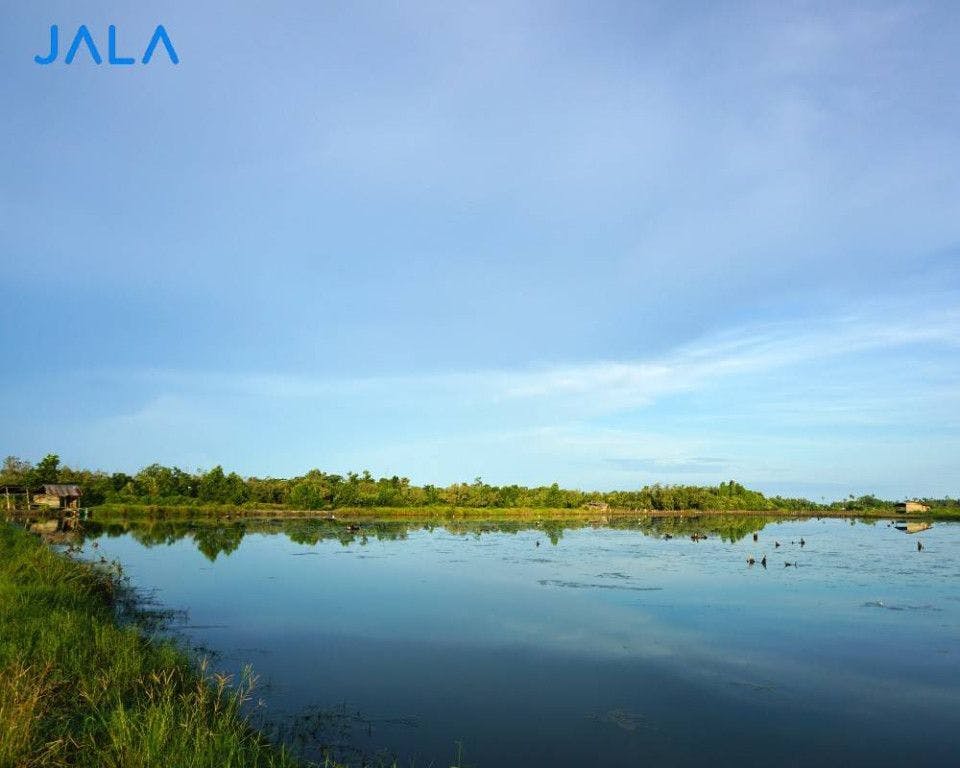Traditional farms or also known as extensive farms have the largest total area in Indonesia, reaching 300,000 hectares. This large area has the potential to be considered in achieving the national shrimp production target.
A farm is categorized as a traditional farm if it has a low stocking density, which is below 100 shrimp/m2. Traditional farms are usually quite large as it generally has at least 0.5 hectares or a land area of 3-10 hectares per plot. Its low productivity relies on natural feed with an average production capacity of 400-500 kg/ha.
Traditional shrimp farmers need to pay attention to the following six (6) things to support their cultivation. What are those?
- Farm construction
Use pond construction with impermeable soil that is able to hold water, and the shape of the pond should have no angles. The maximum water depth is 80 cm to create proper water quality for shrimp.
The design and layout should be set and attempted to get proper water quality and prevent disease transmission. Ideally, the pond consists of sedimentation channels or reservoirs, rearing plots, and collective waste treatment plots or channels. The inlet and outlet gates must also be separated.
- Pond preparation
Pond preparation needs to be done through soil drying, and it usually takes 7-10 days. The signs are the pond soil which is starting to look cracked. Dry the pond under the sun until the subgrade (courtyard) is cracked and check by stepping on it. If it does not collapse (no more than 5 cm), the drying process is finished.
After the drying process, the bottom of the soil is turned over and given lime to improve soil pH. The dose is 1,000 kg/ha if using quicklime or 320 kg/ha if using agricultural lime. Giving lime can destroy microorganisms that have the potential to cause disease. Lime that is given sufficiently can bind phosphate which is needed for the growth of plankton.
- Growing natural feed
Shrimp's natural feed is plankton (phytoplankton and zooplankton). Phytoplankton can be grown by giving fertilizer. The water will turn green if the phytoplankton is successfully grown. Aim for a light green or brownish green watercolor as a simple visual sign if the plankton growing is from a type of beneficial plankton. Also try to keep the green color not too thick to avoid phytoplankton blooming.
- Selecting high-quality shrimp fry
Shrimp fry are an essential key to cultivation, hence farmers need to choose fry that meet high-quality fry standards. The quality of the fry can be seen from the physical appearance of the fry and through several tests. Read more: The Strategy to Choose the Right Shrimp Fry
Collectively, farmers can order shrimp fry from reputable hatcheries so that they can support successful cultivation. Ensuring the quality of the fry also needs to be done before and while stocking the fry correctly. Read: Stocking Shrimp Fry Correctly
- Water quality control
Pond water quality management is conducted by adding water, changing water, adjusting the water depth, fertilizing to grow plankton, and using lime to improve water quality. Visual monitoring of water quality should be carried out periodically based on the color and brightness of the water. Farmers also need to record and document monitoring results.
Traditional farms need to have water quality management standards. Several visual tests can be conducted to identify whether the water quality is adequate or needs improvement. Aim for light green or brownish green with a less dark watercolor. If the water is too concentrated, the shrimp are at risk of suffering a lack of oxygen, especially at night. One of the signs of lack of oxygen is shrimp swimming to the surface or to the shore.
- Harvesting
Harvest when the size of the shrimp reaches a weight of economic value, for example at size 100, or target harvest at the size with the most stable price. It is best to harvest at night or when it is not too hot outside to prevent stress in the harvested shrimp.
Upgrade traditional farms to traditional plus farms
The traditional plus farm is often mentioned in government programs that target shrimp production to reach 2 million tons in 2024. Traditional plus shrimp farm is assumed to achieve productivity of 2-3 tons/ha/year. The existence of traditional plus farms has the potential to maintain a balance between shrimp farming and the environment. However, the availability of other infrastructure such as waterways, road access, and electricity need to be ensured to support pond operations.
The upgrading of traditional farm to traditional plus farm is done by adding pumps and repairing embankments. The pump serves to increase the oxygen supply, especially at night. The embankments are improved to ensure a stronger construction for a higher stocking density. Quoting the statement of Haris Muhtadi (Chairman of SCI) in Kompas, the required investment is around IDR 15-20 million.
Even though the productivity of traditional farms is the lowest, it still has crucial potential in driving the economic wheel and being the most environmentally friendly option. The lack of input in traditional farms, especially feed inputs, causes less waste. By making several improvements such as traditional farms to traditional plus farms, the productivity level can also increase without compromising the impact on nature so that shrimp farming remains productive and sustainable.




